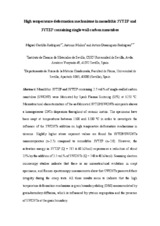High-temperature deformation mechanisms in monolithic 3YTZP and 3YTZP containing single-walled carbon nanotubes
Autor
Castillo-Rodríguez, Miguel
Muñoz, A.
Domínguez-Rodríguez, A.
Editor
WileyFecha
2015Materia
NanotubesZirconia
Composites
Creep
Mechanical properties
METS:
Mostrar el registro METSPREMIS:
Mostrar el registro PREMISMetadatos
Mostrar el registro completo del ítemResumen
Monolithic 3YTZP and 3YTZP containing 2.5 vol% of single-walled carbon nanotubes (SWCNT) were fabricated by Spark Plasma Sintering (SPS) at 1250°C. Microstructural characterization of the as-fabricated 3YTZP/SWCNTs composite shows a homogeneous CNTs dispersion throughout the ceramic matrix. The specimens have been crept at temperatures between 1100°C and 1200°C in order to investigate the influence of the SWCNTs addition on high-temperature deformation mechanisms in zirconia. Slightly higher stress exponent values are found for 3YTZP/SWCNTs nanocomposites (n~2.5) compared to monolithic 3YTZP (n~2.0). However, the activation energy in 3YTZP (Q = 715 ± 60 kJ/mol) experiences a reduction of about 25% by the addition of 2.5 vol% of SWCNTs (Q = 540 ± 40 kJ/mol). Scanning electron microscopy studies indicate that there is no microstructural evolution in crept specimens, and Raman spectroscopy measurements show that SWCNTs preserved their integrity during the creep tests. All these results seem to indicate that the high-temperature deformation mechanism is grain-boundary sliding (GBS) accommodated by grain-boundary diffusion, which is influenced by yttrium segregation and the presence of SWCNTs at the grain boundary.

